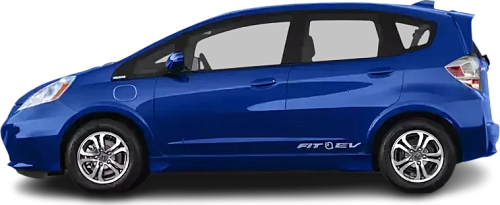USA EV Comparison: Honda Fit EV Gen 1 vs BMW i4 M50
Struggling to Decide? Let AI Help!
Your AI Summary Is Ready!
General Info
Since both vehicles have been discontinued, they are now only available on the used car market. You can get the Honda Fit EV (2013-2015) for as low as $4100, while the BMW i4 M50 (2021-2024) begins at $36990.
The Honda Fit EV (2013-2015) is a Hatchback, whereas the BMW i4 M50 (2021-2024) is a Liftback.
| Property | Honda Fit EV Gen 1 | BMW i4 M50 |
|---|---|---|
| Years of Production | 2013-2015 | 2021-2024 |
| Current Status | Discontinued | Discontinued |
| Country of Manufacture | USA | Germany |
| Body Style | Hatchback | Liftback |
| Market Availability | USA | EU, USA |
| Price USA (Used) | $4100 | $36990 |
| GCC Score | 3.9 | 6.5 |
Range and Efficiency
While the BMW i4 M50 (2021-2024) offers a longer real-world range and a bigger battery, it is less energy-efficient than the Honda Fit EV (2013-2015).
| Property | Honda Fit EV Gen 1 | BMW i4 M50 |
|---|---|---|
| Range (EPA) | 82 mi | 270 mi |
| Range (WLTP) | - Range (WLTP) | 322 mi |
| Range (GCC) | 78 mi | 254 mi |
| Battery Capacity (Nominal) | 20 kWh | 83.9 kWh |
| Battery Capacity (Usable) | 19 kWh | 80.7 kWh |
| Efficiency per 100 mi | 24.4 kWh/100 mi | 31.8 kWh/100 mi |
| Efficiency per kWh | 4.11 mi/kWh | 3.15 mi/kWh |
| Range and Efficiency Score | 5.4 | 6.3 |
Charging
Both vehicles utilize a standard 400-volt architecture.
The Honda Fit EV (2013-2015) has no DC fast charging capability, whereas the BMW i4 M50 (2021-2024) can charge at up to 207 kW.
The BMW i4 M50 (2021-2024) features a more powerful on-board charger, supporting a maximum AC charging power of 11 kW, whereas the Honda Fit EV (2013-2015) is limited to 6.6 kW.
| Property | Honda Fit EV Gen 1 | BMW i4 M50 |
|---|---|---|
| Max Charging Power (AC) | 6.6 kW | 11 kW |
| Max Charging Power (DC) | - Max Charging Power (DC) | 207 kW |
| Architecture | 400 V | 400 V |
| Charge Port | Type 1 (J1772) | CCS Type 1 |
| Charging Score | 2.7 | 6.9 |
Performance
The Honda Fit EV (2013-2015) is front-wheel drive, while the BMW i4 M50 (2021-2024) offers an all-wheel drive system.
The BMW i4 M50 (2021-2024) boasts greater motor power and accelerates faster from 0 to 60 mph.
| Property | Honda Fit EV Gen 1 | BMW i4 M50 |
|---|---|---|
| Drive Type | FWD | AWD |
| Motor Type | PMSM | PMSM (front), PMSM (rear) |
| Motor Power (kW) | 92 kW | 400 kW |
| Motor Power (hp) | 123 hp | 536 hp |
| Motor Torque | 189 lb-ft | 586 lb-ft |
| 0-60 mph | 8.1 s | 3.7 s |
| Top Speed | 90 mph | 140 mph |
| Performance Score | 2.7 | 6.7 |
Dimensions
The BMW i4 M50 (2021-2024) boasts a more extended wheelbase.
| Property | Honda Fit EV Gen 1 | BMW i4 M50 |
|---|---|---|
| Length | 161.6 in | 188.3 in |
| Width (with Mirrors) | 66.7 in | 81.6 in |
| Width (w/o Mirrors) | - Width (w/o Mirrors) | 72.9 in |
| Height | 60 in | 57 in |
| Wheelbase | 98.4 in | 112.4 in |
Cargo and Towing
Neither car is equipped with a frunk (front trunk).
The BMW i4 M50 (2021-2024) has a towing capacity of up to 3500 lb, whereas the Honda Fit EV (2013-2015) is not officially rated for towing in the US.
| Property | Honda Fit EV Gen 1 | BMW i4 M50 |
|---|---|---|
| Number of Seats | 5 | 5 |
| Curb Weight | 3252 lb | 5018 lb |
| Cargo Volume (Trunk) | 12 ft3 | 16.6 ft3 |
| Cargo Volume (Max) | - Cargo Volume (Max) | 45.6 ft3 |
| Cargo Volume (Frunk) | - Cargo Volume (Frunk) | - Cargo Volume (Frunk) |
| Towing Capacity | - Towing Capacity | 3500 lb |
| Cargo and Towing Score | 4 | 5 |




